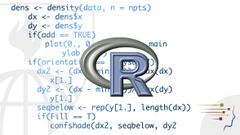Online courses directory (684)
In this course, we will study security and trust from the hardware perspective. Upon completing the course, students will understand the vulnerabilities in current digital system design flow and the physical attacks to these systems. They will learn that security starts from hardware design and be familiar with the tools and skills to build secure and trusted hardware.
6.301 is a course in analog circuit analysis and design. We cover the tools and methods necessary for the creative design of useful circuits using active devices. The class stresses insight and intuition, applied to the design of transistor circuits and the estimation of their performance. We concentrate on circuits using the bipolar junction transistor, but the techniques that we study can be equally applied to circuits using JFETs, MOSFETs, MESFETs, future exotic devices, or even vacuum tubes.
6.541J surveys the structural properties of natural languages, with special emphasis on the sound pattern. Topics covered include: representation of the lexicon; physiology of speech production; articulatory phonetics; acoustical theory of speech production; acoustical and articulatory descriptions of phonetic features and of prosodic aspects of speech; perception of speech; models of lexical access and of speech production and planning; and applications to recognition and generation of speech by machine, and to the study of speech disorders.
This course examines the fundamentals of detection and estimation for signal processing, communications, and control. Topics covered include: vector spaces of random variables; Bayesian and Neyman-Pearson hypothesis testing; Bayesian and nonrandom parameter estimation; minimum-variance unbiased estimators and the Cramer-Rao bounds; representations for stochastic processes, shaping and whitening filters, and Karhunen-Loeve expansions; and detection and estimation from waveform observations. Advanced topics include: linear prediction and spectral estimation, and Wiener and Kalman filters.
This is a laboratory experience course with a focus on photography, electronic imaging, and light measurement, much of it at short duration. In addition to teaching these techniques, the course provides students with experience working in a laboratory and teaches good work habits and techniques for approaching laboratory work. A major purpose of 6.163 is to provide students with many opportunities to sharpen their communication skills: oral, written, and visual.
This course introduces students to the principles of computation. Upon completion of 6.001, students should be able to explain and apply the basic methods from programming languages to analyze computational systems, and to generate computational solutions to abstract problems. Substantial weekly programming assignments are an integral part of the course. This course is worth 4 Engineering Design Points.
This course surveys techniques to fabricate and analyze submicron and nanometer structures, with applications. Optical and electron microscopy is reviewed. Additional topics that are covered include: surface characterization, preparation, and measurement techniques, resist technology, optical projection, interferometric, X-ray, ion, and electron lithography; Aqueous, ion, and plasma etching techniques; lift-off and electroplating; and ion implantation. Applications in microelectronics, microphotonics, information storage, and nanotechnology will also be explored.
Acknowledgements
The Instructors would like to thank Bob Barsotti, Bryan Cord, and Ben Wunsch for their work on the Atomic Force Microscope video. They would also like to thank Bryan Cord for creating each video.
Helping you build human-centered design skills, so that you have the principles and methods to create excellent interfaces with any technology.
Learn the basic components of building and applying prediction functions with an emphasis on practical applications. This is the eighth course in the Johns Hopkins Data Science Specialization.
This course introduces the basic mathematical and programming principles that underlie much of Computer Science. Students will refine their programming skills as well as learn the basics of creating efficient solutions to common computational problems.
This course is offered to graduates and includes topics such as mathematical models of systems from observations of their behavior; time series, state-space, and input-output models; model structures, parametrization, and identifiability; non-parametric methods; prediction error methods for parameter estimation, convergence, consistency, and asymptotic distribution; relations to maximum likelihood estimation; recursive estimation; relation to Kalman filters; structure determination; order estimation; Akaike criterion; bounded but unknown noise model; and robustness and practical issues.
6.825 is a graduate-level introduction to artificial intelligence. Topics covered include: representation and inference in first-order logic, modern deterministic and decision-theoretic planning techniques, basic supervised learning methods, and Bayesian network inference and learning.
This course was also taught as part of the Singapore-MIT Alliance (SMA) programme as course number SMA 5504 (Techniques in Artificial Intelligence).
This course teaches simple reasoning techniques for complex phenomena: divide and conquer, dimensional analysis, extreme cases, continuity, scaling, successive approximation, balancing, cheap calculus, and symmetry. Applications are drawn from the physical and biological sciences, mathematics, and engineering. Examples include bird and machine flight, neuron biophysics, weather, prime numbers, and animal locomotion. Emphasis is on low-cost experiments to test ideas and on fostering curiosity about phenomena in the world.
6.803/6.833 is a course in the department's "Artifical Intelligence and Applications" concentration. This course is offered both to undergraduates (6.803) and graduates (6.833). 6.803/6.833 is designed to help students learn about progress toward the scientific goal of understanding human intelligence from a computational point of view. This course complements 6.034, because 6.803/6.833 focuses on long-standing scientific questions, whereas 6.034 focuses on existing tools for building applications with reasoning and learning capability. The content of 6.803/6.833 is largely based on papers by representative Artificial Intelligence leaders, which serve as the basis for discussion and assignments for the course.
This course is an introduction to the theory that tries to explain how minds are made from collections of simpler processes. It treats such aspects of thinking as vision, language, learning, reasoning, memory, consciousness, ideals, emotions, and personality. It incorporates ideas from psychology, artificial intelligence, and computer science to resolve theoretical issues such as wholes vs. parts, structural vs. functional descriptions, declarative vs. procedural representations, symbolic vs. connectionist models, and logical vs. common-sense theories of learning.
In this course----the third in a trans-institution sequence of MOOCs on Mobile Cloud Computing with Android--we will learn how to connect Android mobile devices to cloud computing and data storage resources, essentially turning a device into an extension of powerful cloud-based services on popular cloud computing platforms, such as Google App Engine and Amazon EC2.
Learn how to program in R and how to use R for effective data analysis. This is the second course in the Johns Hopkins Data Science Specialization.
Learn the concepts and tools behind reporting modern data analyses in a reproducible manner. This is the fifth course in the Johns Hopkins Data Science Specialization.
Get an overview of the data, questions, and tools that data analysts and data scientists work with. This is the first course in the Johns Hopkins Data Science Specialization.
6.933J / STS.420J provides an integrated approach to engineering practice in the real world. Students of 6.933J / STS.420J research the life cycle of a major engineering project, new technology, or startup company from multiple perspectives: technical, economic, political, and cultural. Research involves interviewing inventors, reading laboratory notebooks, evaluating patents, and looking over the shoulders of engineers as they developed today's technologies. This subject is for students who recognize that technical proficiency alone is only part of the formula for success in technology.
Trusted paper writing service WriteMyPaper.Today will write the papers of any difficulty.





















